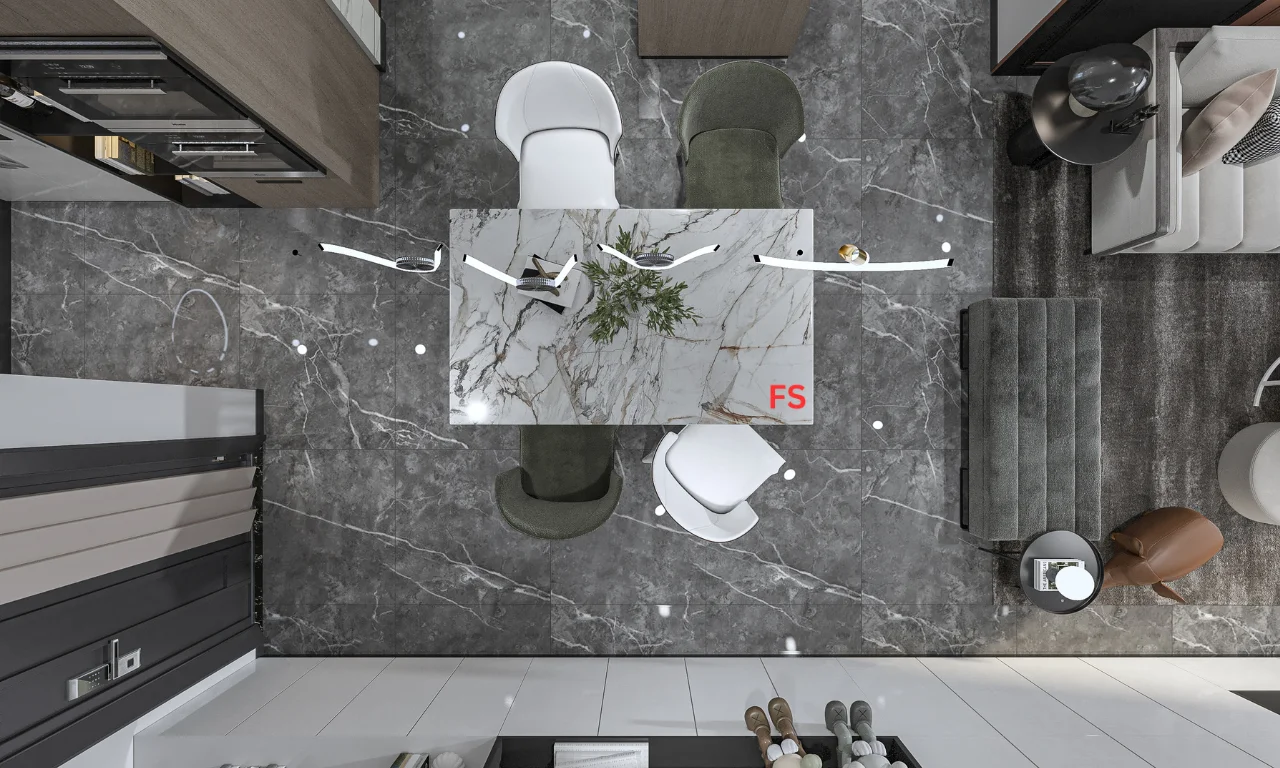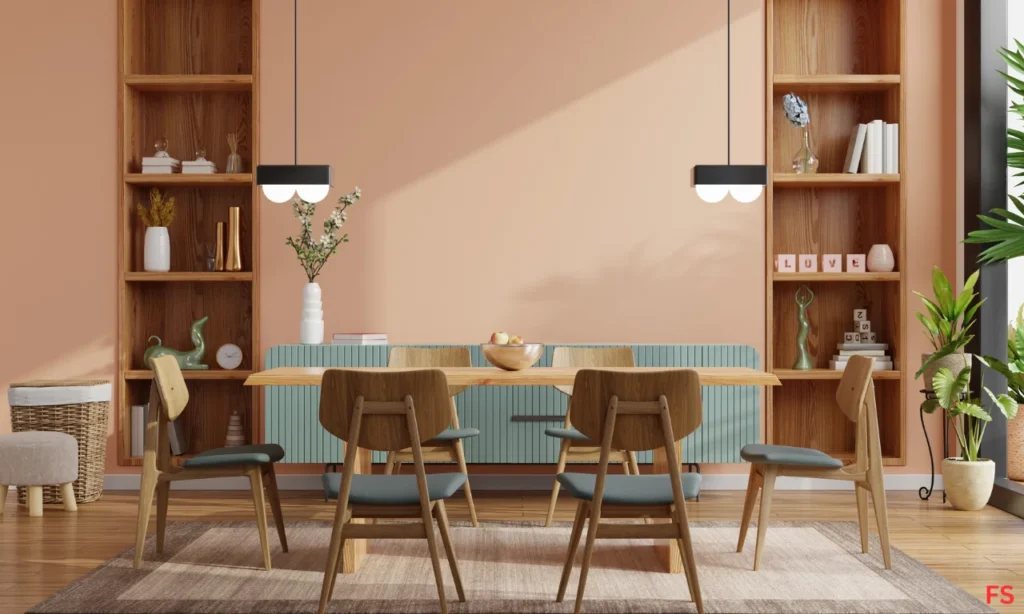The way we live has dramatically changed over the decades. With busier lifestyles, fewer people have the time or inclination to sit down for a formal meal. Instead, families are opting for more casual and flexible dining arrangements.
Quick meals, takeout, and on-the-go snacks have replaced the leisurely dinners of the past. Additionally, the advent of technology and the increasing pace of life have contributed to this shift, as people seek more convenient and time-saving solutions for daily routines.
Dining Rooms Disappearing: A Shift in Lifestyle
The traditional dining room’s decline can also be attributed to the rise of open-plan living.. Homes now feature seamless transitions between the kitchen, living, and dining areas, creating a more inclusive and versatile space.
This design fosters a sense of openness and connectivity, allowing family members to interact more freely. It also enhances natural light flow and creates an airy, spacious feel in the home. The open-plan concept aligns with contemporary preferences for modern, uncluttered living spaces that prioritize comfort and functionality.
Multifunctional Spaces
In today’s homes, spaces need to be multifunctional. The dining room is often repurposed as a home office, playroom, or additional living area, reflecting the diverse needs of modern families. This adaptability ensures that every square foot of a home is utilized efficiently, catering to activities ranging from work and study to leisure and entertainment.
Multifunctional spaces are particularly valuable in urban environments where living areas may be limited. By merging functions, homeowners can create dynamic spaces that evolve with their changing needs and lifestyles.
 Designing a Dining Space for Small Homes
Designing a Dining Space for Small Homes
Compact Furniture
Choose furniture that is small and adaptable without taking up too much space. Chairs and tables that can be stacked and folded can be great choices. When not in use, these items are simple to store away, freeing up valuable floor space.Look for sleek, minimalist designs that provide functionality without adding bulk.
Compact furniture allows you to make the most of limited space while maintaining a clean and uncluttered look. Choose items that can be effortlessly moved and rearranged, offering flexibility in how you use your dining area.
Smart Storage Solutions
Incorporate smart storage solutions to keep your dining area tidy. Consider wall-mounted shelves or furniture with built-in storage.These options help maximize space and keep the area organized. Built-in storage benches, for example, can double as seating and storage for dining essentials.
Wall-mounted shelves provide easy access to frequently used items while keeping them off the table and countertops. Smart storage solutions are essential for maintaining a neat and functional dining space, especially in smaller homes where every inch of space matters.
Use of Mirrors
A small space can appear to be larger and more open by using mirrors. Place a mirror opposite a window to reflect light and create the illusion of more space. This simple trick can brighten up the dining area and make it feel more expansive. Pick a fashionable mirror that matches your decor and adds a touch of class.
Mirrors not only add visual interest to a room, but they also give it a sense of depth and dimension.. This can be particularly beneficial in compact dining areas, where It is essential to give the impression of additional space.
Light Colors and Minimalist Decor
Light colors and minimalist decor can make a small dining area feel airy and spacious. Avoid heavy, dark furnishings that can make the space feel cramped. Opt for a neutral color palette, incorporating soft tones and light shades that reflect natural light.
Minimalist decor emphasizes simplicity and functionality, creating a clean and uncluttered look. Choose furniture and decor items that are both practical and aesthetically pleasing, avoiding unnecessary embellishments. This approach helps create a serene and inviting dining space, perfect for small homes.
Conclusion
The disappearing dining room reflects broader trends in home design and lifestyle. By embracing open-plan living and multifunctional spaces, we can create homes that are more adaptable, social, and practical. Whether you’re designing a new home or renovating an existing one, consider how these trends can enhance your living space. Embrace the change and make your home work for you.
The flexibility and modernity of open-plan designs offer numerous benefits, making them an attractive option for contemporary living. As we continue to evolve in how we use our home spaces, the dining room’s disappearance marks a significant shift towards more efficient and versatile living environments.
FAQ: Dining Rooms Disappearing
Why are Dining Rooms Disappearing?
Dining rooms are disappearing due to changing lifestyles, the rise of open-plan living, and the need for multifunctional spaces. Modern families prioritize convenience and flexibility, making traditional dining rooms less relevant.
The trend towards casual dining and the increasing popularity of kitchen islands and breakfast bars have also contributed to this shift. Additionally, the desire for spaces that can serve multiple purposes, such as home offices or playrooms, has led to the repurposing of dining rooms. As a result, the formal dining room is becoming a rarity in contemporary home design.
What advantages does not having a dining room bring?
Benefits include increased space, enhanced social interaction, and greater flexibility in how you use your home. Eliminating the dining room allows for a more open and cohesive living area, which can be adapted to suit various activities.
It can also lead to a more efficient use of space, especially in smaller homes where every square foot counts. Furthermore, open-plan layouts encourage family members to spend more time together, fostering stronger bonds and improving communication. Overall, the absence of a dedicated dining room offers numerous advantages in terms of space utilization and lifestyle enhancement.
Without a dedicated dining room, how can I create a dining area?
Define your space with rugs and lighting, choose multifunctional furniture, consider built-ins, utilize vertical space, and create ambiance with decor. Even without a separate dining room, you can create a functional and inviting dining area by carefully planning and designing the space.
Use strategic furniture placement and design elements to delineate the dining zone within an open-plan layout. Incorporate stylish and practical furniture that can serve multiple purposes, ensuring that the area is both functional and aesthetically pleasing. You can design a dining area that meets your needs and matches your home by paying attention to details like lighting, storage, and decor.
How can I design a dining space in a small home?
Opt for compact furniture, incorporate smart storage solutions, use mirrors to create the illusion of space, and choose light colors and minimalist decor. Designing a dining area in a small home requires careful planning and creativity.Avoid bulky pieces of furniture that could take up too much space by being too big for the room.
Utilize storage solutions that keep the dining area organized and clutter-free, maximizing the available space. Incorporate mirrors to enhance natural light and create a sense of openness. Choose a light and neutral color palette to make the space feel airy and spacious. You can create a dining area that works well and looks good in a small home by decorating in a minimalist way.

